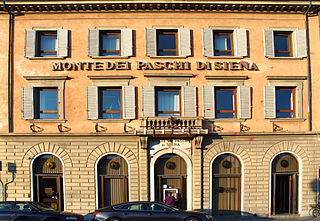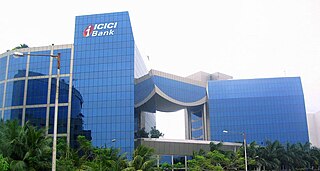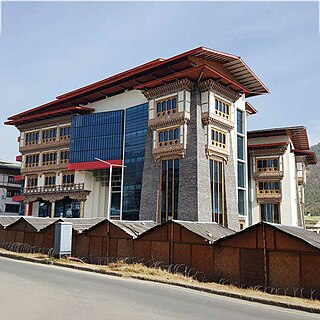
A financial institution, sometimes called a banking institution, is a business entity that provides service as an intermediary for different types of financial monetary transactions. Broadly speaking, there are three major types of financial institution:
- Depository institution – deposit-taking institution that accepts and manages deposits and makes loans, including bank, building society, credit union, trust company, and mortgage broker;
- Contractual institution – insurance company and pension fund
- Investment institution – investment bank, underwriter, and other different types of financial entities managing investments.

The Reserve Bank of India, abbreviated as RBI, is India's central bank and regulatory body responsible for regulation of the Indian banking system. Owned by the Ministry of Finance, Government of India, it is responsible for the control, issue and maintaining supply of the Indian rupee. It also manages the country's main payment systems and works to promote its economic development. Bharatiya Reserve Bank Note Mudran (BRBNM) is a specialised division of RBI through which it prints and mints Indian currency notes (INR) in two of its currency printing presses located in Mysore and Salboni. The RBI, along with the Indian Banks' Association, established the National Payments Corporation of India to promote and regulate the payment and settlement systems in India. Deposit Insurance and Credit Guarantee Corporation was established by RBI as one of its specialized division for the purpose of providing insurance of deposits and guaranteeing of credit facilities to all Indian banks.

DBS Bank Limited is a Singaporean multinational banking and financial services corporation headquartered at the Marina Bay Financial Centre in the Marina Bay district of Singapore. The bank was previously known as The Development Bank of Singapore Limited, which "DBS" was derived from, before the present abbreviated name was adopted on 21 July 2003 to reflect its role as a global bank. It is one of the "Big Three" local banks in Singapore, along with Oversea-Chinese Banking Corporation (OCBC) and United Overseas Bank (UOB).

The ngultrum is the currency of the Kingdom of Bhutan. It can be literally translated as 'silver' for ngul and 'coin' for trum. It is subdivided into 100 chhertum. The Royal Monetary Authority of Bhutan, the central bank of Bhutan is the minting authority of the ngultrum banknotes and coins. The ngultrum is currently pegged to the Indian rupee at parity.

ICICI Bank Limited is an Indian multinational bank and financial services company headquartered in Mumbai with a registered office in Vadodara. It offers a wide range of banking and financial services for corporate and retail customers through various delivery channels and specialized subsidiaries in the areas of investment banking, life, non-life insurance, venture capital and asset management.

Bangladesh Bank is the central bank of Bangladesh and is a member of the Asian Clearing Union. It is fully owned by the Government of Bangladesh.
Equitable PCI Bank, Inc. was one of the largest banks in the Philippines, being the third-largest bank in terms of assets. It was the largest bank before it was overtaken by Metrobank in 1995. It is the result of the merger of Equitable Banking Corporation and Philippine Commercial International Bank or PCIBank. It was known for a wide range of services from savings to insurance and, through its wholly owned subsidiary Equitable Card Network, was the largest Philippine credit card issuer. The bank merged with Banco de Oro Universal Bank in early 2007, and is now branded as BDO as its new identity as part of the new Banco de Oro Unibank, Inc.
The IDBI Bank Limited is a Scheduled Commercial Bank under the ownership of Life Insurance Corporation of India (LIC) and Government of India. It was established by Government of India as a wholly owned subsidiary of Reserve Bank of India in 1964 as Industrial Development Bank of India, a Development Finance Institution, which provided financial services to industrial sector. In 2005, the institution was merged with its subsidiary commercial division, IDBI Bank, and was categorised as "Other Development Finance Institution" category. Later in March 2019, Government of India asked LIC to infuse capital in the bank due to high NPA and capital adequacy issues and also asked LIC to manage the bank to meet the regulatory norms. Consequent upon LIC acquiring 51% of the total paid-up equity share capital, the bank was categorised as a 'Private Sector Bank' for regulatory purposes by Reserve Bank of India with effect from 21 January 2019. IDBI was put under Prompt Corrective Action of the Reserve Bank of India and on 10 March 2021 IDBI came out of the same. At present direct and indirect shareholding of Government of India in IDBI Bank is approximately 95%, which Government of India (GoI) vide its communication F.No. 8/2/2019-BO-II dated 17 December 2019, has clarified and directed all Central/State Government departments to consider IDBI Bank for allocation of Government Business. Many national institutes find their roots in IDBI like SIDBI, EXIM, National Stock Exchange of India, SEBI, National Securities Depository Limited. Presently, IDBI Bank is one of the largest Commercial Banks in India.

RHB Bank Berhad is a Malaysian bank based in Kuala Lumpur and founded in 1997. It is the fourth largest fully integrated financial services group in Malaysia.

The Royal Monetary Authority of Bhutan is the central bank of Bhutan and is a member of the Asian Clearing Union. It is also the minting authority for the Bhutanese Ngultrum. The Royal Monetary Authority of Bhutan was established under the Royal Monetary Authority of Bhutan Act of 1982. Subsequently, the Act of 1982 was amended by the Financial Institutions Act of 1992 and replaced in its entirety by the Royal Monetary Authority Act of 2010.

AmBank Group comprises AMMB Holdings Berhad is one of the largest banking groups in Malaysia whose core businesses are retail banking, wholesale banking, Islamic banking, and life and general insurance.
China's banking sector had CN¥319.7 trillion in assets at the end of 2020. The "Big Four" state-owned commercial banks are the Bank of China, the China Construction Bank, the Industrial and Commercial Bank of China, and the Agricultural Bank of China, all of which are among the largest banks in the world As of 2018. Other notable big and also the largest banks in the world are China Merchants Bank and Ping An Bank.

Japan Post Bank Co., Ltd. is a Japanese bank headquartered in Tokyo. It is a corporation held by Japan Post Holdings, in which the government of Japan has a majority stake.
Bangladesh is a developing country with an impoverished banking system, particularly in terms of the services and customer care provided by the government run banks. In recent times, private banks are trying to imitate the banking structure of the more developed countries, but this attempt is often foiled by inexpert or politically motivated government policies executed by the central bank of Bangladesh, Bangladesh Bank. The outcome is a banking system fostering corruption and illegal monetary activities/laundering etc. by the politically powerful and criminals, while at the same time making the attainment of services or the performance of international transactions difficult for the ordinary citizens, students studying abroad or through distance learning, general customers etc.
Before Uganda's independence in 1962, the main banks in Uganda were Barclays ; Grindlays, Standard Bank and the Bank of Baroda from India. The currency was issued by the East African Currency Board, a London-based body. In 1966, the Bank of Uganda (BoU), which controlled the issue of currency and managed foreign exchange reserves, became the central bank and national banking regulator. The government-owned Uganda Commercial Bank and the Uganda Development Bank were launched in the 1960s. The Uganda Development Bank is a state-owned development finance institution, which channeled loans from international sources into Ugandan enterprises and administered most of the development loans made to Uganda.

A bank is a financial institution that accepts deposits from the public and creates a demand deposit while simultaneously making loans. Lending activities can be directly performed by the bank or indirectly through capital markets.
The New York State Banking Department was created by the New York Legislature on April 15, 1851, with a chief officer to be known as the Superintendent. The New York State Banking Department was the oldest bank regulatory agency in the United States.

Bhutan National Bank is a commercial bank founded in 1997 and located in Thimphu, capital of the Kingdom of Bhutan.

Bank of Bhutan (BoB) is the largest and oldest commercial bank in Bhutan. It was established under the provision of the royal charter of May 1968. It was also the only central bank before the Royal Monetary Authority of Bhutan in 1982. It is registered under the Companies Act of Bhutan, 2000 as a public sector commercial bank.














